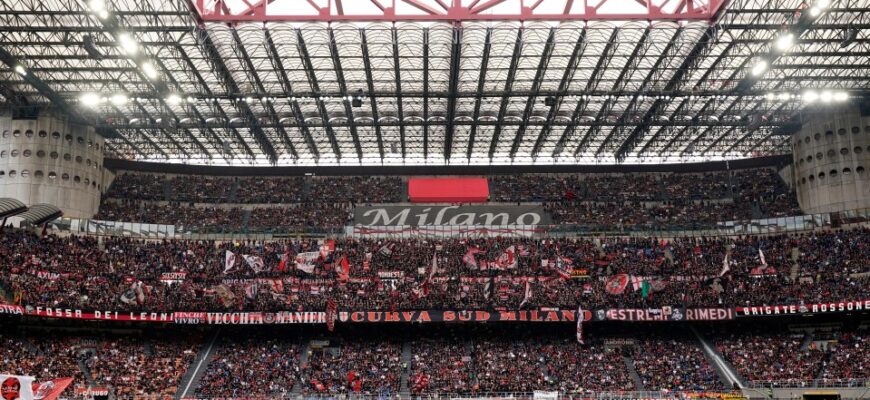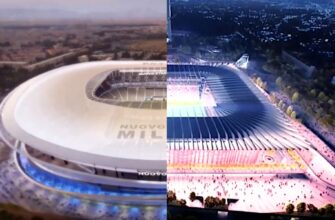The legendary San Siro, a colossus steeped in footballing folklore, stands at a crossroads. For decades, it has been the hallowed ground for both Inter and AC Milan, witnessing triumphs and heartbreaks that have woven themselves into the fabric of Italian and global football. But as the sport evolves, so too must its venues. Milan is now poised for a monumental architectural undertaking: a new stadium that promises to blend cutting-edge design with a reimagined fan experience, securing the future for two of Europe`s most iconic clubs. The question, however, remains: how does one replace a legend?
- Farewell to the Past, Hello to the Future: The Architectural Blueprint
- Capacity and Comfort: A Stadium for the Modern Era
- Beyond the Ninety Minutes: A Commercial and Entertainment Hub
- Urban Regeneration: A Greener, More Vibrant District
- The Architects: Maestros of Modern Stadium Design
- The San Siro Legacy: A New Dawn
Farewell to the Past, Hello to the Future: The Architectural Blueprint
While the detailed blueprints are still being meticulously drafted by the renowned architectural firms Foster + Partners and Manica, initial insights from the “Docfap” (Feasibility Document of Project Alternatives), presented by both clubs in March 2025, offer a tantalizing glimpse into the future. It’s clear this won`t be merely an updated version of the existing Giuseppe Meazza. This is a complete re-imagination.
The most striking departure will be the stadium`s shape. Eschewing the current rectangular footprint, the new arena is envisioned as a more ovalized structure. This modern contour will also mean the iconic red support beams that define San Siro`s current profile will be absent, marking a clear architectural break from the past. For traditionalists, this might sting a little, but for those focused on functionality and contemporary aesthetics, it represents a necessary evolution.
Capacity and Comfort: A Stadium for the Modern Era
One of the key debates around new stadium builds often centers on capacity. Initially, a reduction to 60,000 spectators was considered, but the final plan wisely settles on a robust 71,500 seats. This capacity largely mirrors the current San Siro, ensuring that the electric atmosphere of major Milan derbies and European nights won`t be diluted. However, the experience within will be vastly different:
- Two Rings, Not Three: Unlike the existing Meazza, the new design will feature two main seating tiers, promising improved sightlines and a more intimate connection to the pitch. It`s a pragmatic choice, avoiding the dizzying heights of the third tier that some fans might affectionately (or less so) remember.
- Fixed Roof: The stadium will boast a fixed roof, providing shelter from Milan’s occasional inclement weather. Unlike some modern marvels like the Tottenham Hotspur Stadium, the pitch itself will not be retractable. Simplicity, it seems, has its virtues.
- Accessibility for All: A crucial upgrade will be the integration of dedicated spaces for disabled spectators across all sectors. This is a significant improvement over the current setup, where accessibility is often confined to limited areas. Modern stadiums are, after all, meant for everyone.
Beyond the Ninety Minutes: A Commercial and Entertainment Hub
In today`s football landscape, a stadium is more than just a place to watch a game; it`s a revenue-generating ecosystem. The new San Siro is designed with this philosophy at its core, placing immense importance on commercial and hospitality areas. One could almost hear the rustle of banknotes already.
Imagine vast internal concourses bustling with activity, featuring an array of restaurants and retail shops. This isn`t just about pre-match pies and post-match scarves; it`s about creating an all-encompassing destination that draws visitors throughout the week, not just on match days. Corporate hospitality suites will also be a major feature, offering premium experiences that, let`s be honest, help balance the books for clubs competing at the highest levels.
The entire structure is planned to sit atop a “podium” or base, with the vision of positioning club museums and stores directly in the plaza facing the main stand. This strategic placement ensures that the history and brand of Inter and AC Milan are celebrated and accessible, further enhancing the visitor experience and, naturally, the retail opportunities.
Urban Regeneration: A Greener, More Vibrant District
The ambition for the new San Siro extends far beyond the stadium walls, aiming to revitalize the surrounding district. This is where the project truly earns its “urban development” stripes. While a portion of the old Meazza is slated for demolition, the plan includes retaining parts of the historic structure, repurposing them for commercial and entertainment uses – perhaps even a dedicated San Siro museum. A clever way to acknowledge history without being shackled by it.
The project commits to a substantial environmental footprint: at least 50% of the area will remain non-concretized, and a generous 80,000 square meters of green space will be returned to municipal ownership upon completion. In a bustling metropolis like Milan, this green lung is a welcome respite.
Furthermore, the surrounding area will undergo significant development:
- Offices: 43,000 square meters of gross floor area dedicated to commercial offices.
- Hotels: 20,000 square meters for new hotel accommodations, catering to both match-day visitors and general tourism.
- Parking: A substantial 15,000 square meters for parking facilities, addressing one of the current venue`s perennial challenges.
The vision is clear: transform the San Siro district into a dynamic hub, not just for football, but for business, leisure, and community life. The illustrations in the Docfap might be “purely indicative,” but they paint a picture of a vibrant, modern cityscape, albeit one that must thoughtfully integrate with existing residential areas.
The Architects: Maestros of Modern Stadium Design
Entrusting the design to `Foster + Partners` and Manica is like fielding a dream team of architectural talent. Lord Norman Foster`s firm is synonymous with iconic structures worldwide, pushing boundaries in sustainability and innovation. Manica, meanwhile, brings specialized expertise in sports venue design, having conceptualized modern stadiums globally. As the original article rather aptly put it, having these two powerhouses collaborating on the project is “like having Pirlo and Suárez creating football” – a confluence of visionaries destined to deliver something extraordinary.
The San Siro Legacy: A New Dawn
The impending transformation of San Siro is more than just a stadium project; it’s a statement about ambition, modernity, and the evolving nature of elite sports. While the sentimental attachment to the old Meazza is undeniably strong, the financial realities and fan experience demands of the 21st century necessitate a bold step forward. The new stadium, with its thoughtful design, enhanced amenities, and integrated urban plan, aims to provide Inter and AC Milan with a world-class home that secures their competitive future, both on and off the pitch. It may not echo the exact history of its predecessor, but it seeks to build a new one, perhaps with more comfortable seats and better bathrooms, but certainly with the same Milanese passion.









